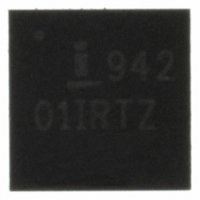ISL94201IRZ Intersil, ISL94201IRZ Datasheet - Page 12

ISL94201IRZ
Manufacturer Part Number
ISL94201IRZ
Description
IC MULTI LI-ION AFE 24-QFN
Manufacturer
Intersil
Datasheet
1.ISL94201IRZ.pdf
(19 pages)
Specifications of ISL94201IRZ
Function
Over/Under Voltage Protection
Battery Type
Lithium-Ion (Li-Ion)
Voltage - Supply
5 V ~ 10 V
Operating Temperature
-40°C ~ 85°C
Mounting Type
Surface Mount
Package / Case
24-VFQFN Exposed Pad
Lead Free Status / RoHS Status
Lead free / RoHS Compliant
Available stocks
Company
Part Number
Manufacturer
Quantity
Price
Company:
Part Number:
ISL94201IRZ
Manufacturer:
Intersil
Quantity:
25
Part Number:
ISL94201IRZ
Manufacturer:
INTERSIL
Quantity:
20 000
Protection Functions
In the default recommended condition, the
ISL94201automatically detects internal over-temperature,
and external over-temperature conditions. The designer
programs the microcontroller to respond to the
over-temperature indications.
OVER-TEMPERATURE SAFETY FUNCTIONS
External Temperature Monitoring
The external temperature is monitored by using a voltage
divider consisting of a fixed resistor and a thermistor. This
divider is powered by the ISL94201TEMP3V output. This
output is normally controlled so it is on for only short periods
to minimize current consumption.
Without microcontroller intervention, and in the default state,
the ISL94201provides an automatic temperature scan. This
scan circuit repeatedly turns on TEMP3V output (and the
external temperature monitor) for 5ms out of every 640ms.
In this way, the external temperature is monitored even if the
microcontroller is asleep.
When the TEMP3V output turns on, the ISL94201waits 1ms
for the temperature reading to stabilize, then compares the
external temperature voltage with an internal voltage divider
that is set to TEMP3V/13. When the thermistor voltage is
below the reference threshold after the delay, an external
temperature fail condition exists. To set the external
over-temperature limit, set the value of R
resistance of the thermistor at the over-temp threshold.
The TEMP3V output pin also turns on when the
microcontroller sets the AO3:AO0 bits to select that the
external temperature voltage. This causes the TEMPI
voltage to be placed on AO and activates (after 1ms) the
over-temperature detection. As long as the AO3:AO0 bits
V
FIGURE 3. WAKE UP CONTROL CIRCUITS
ISL94201
CELL1
(STATUS)
WAKE UP
CIRCUITS
WKUP
(CONTROL)
* Internal resistor
only connected when
WKPOL=1.
12
WKPOL
X
resistor to 12x the
230k*
5V
VSS
WKUP
ISL94201
point to the external temperature, the TEMP3V output
remains on.
Because of the manual scan of the temperature, it may be
desired to turn off the automatic scan, although they can be
used at the same time without interference. To turn off the
automatic scan, set the ATMPOFF bit.
The microcontroller can over-ride both the automatic
temperature scan and the microcontroller controlled
temperature scan by setting the TEMP3ON configuration bit.
This turns on the TEMP3V output to keep the temperature
control voltage on all the time, for a continuous monitoring of
an over-temperature condition. This likely will consume a
significant amount of current, so this feature is usually used
for special or test purposes.
Analog Multiplexer Selection
The ISL94201devices can be used to externally monitor
individual battery cell voltages and temperatures. Each
quantity can be monitored at the analog output pin (AO). The
desired voltage is selected using the I
AO3:AO0 bits. See Figure 5.
VOLTAGE MONITORING
Since the voltage on each of the Li-ion Cells are normally
higher than the regulated supply voltage, and since the
voltages on the upper cells is much higher than is tolerated
by a microcontroller, it is necessary to both level shift and
divide the voltage before it can be monitored by the
microcontroller or an external A/D converter. To get into the
voltage range required by the external circuits, the voltage
level shifter divides the cell voltage by 2 and references it to
VSS. Therefore, a Li-ion cell with a voltage of 4.2V becomes
a voltage of 2.1V on the AO pin.
TEMPERATURE MONITORING
The voltage representing the external temperature applied at
the TEMPI terminal is directed to the AO terminal through a
MUX, as selected by the AO control bits (see Figures 4
and 5). The external temperature voltage is not divided by 2
as are the cell voltages. Instead it is a direct reflection of the
voltage at the TEMPI pin.
A similar operation occurs when monitoring the internal
temperature through the AO output, except there is no
external “calibration” of the voltage associated with the
internal temperature. For the internal temperature
monitoring, the voltage at the output is linear with respect to
temperature. See “Operating Specifications” for information
about the output voltage at +25°C and the output slope
relative to temperature on page 4.
2
C interface and the
July 3, 2008
FN6719.0











